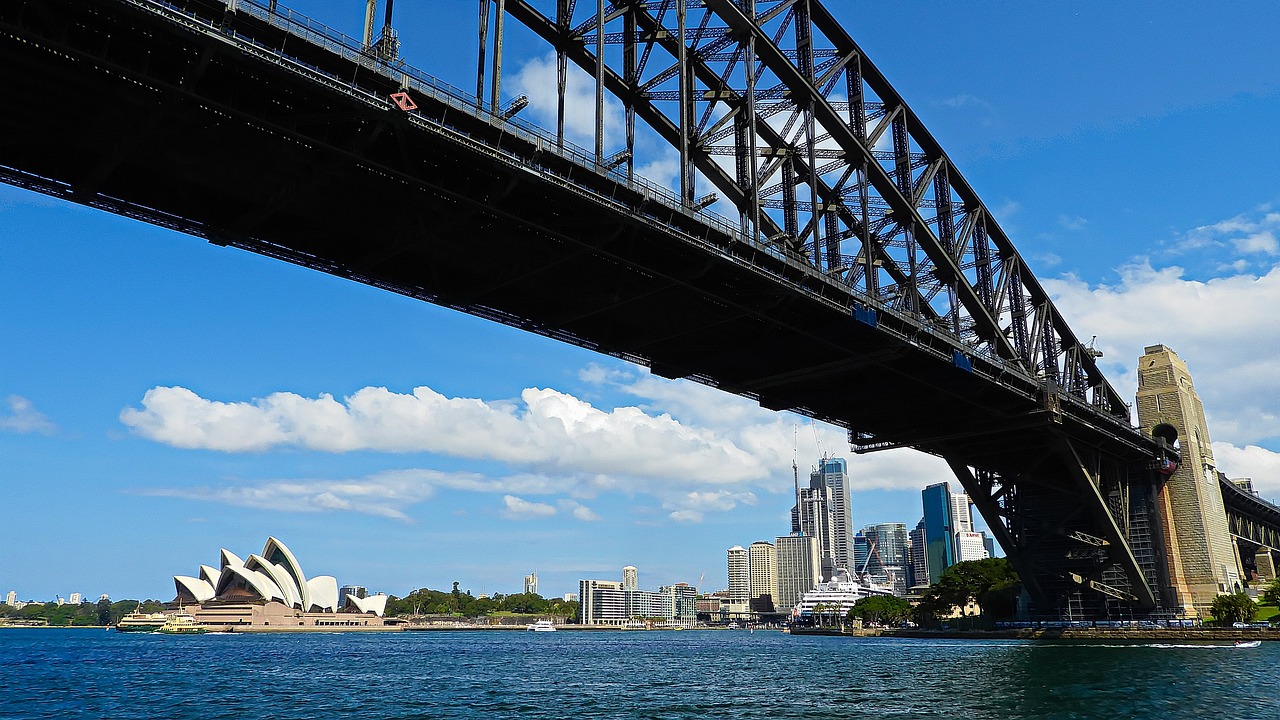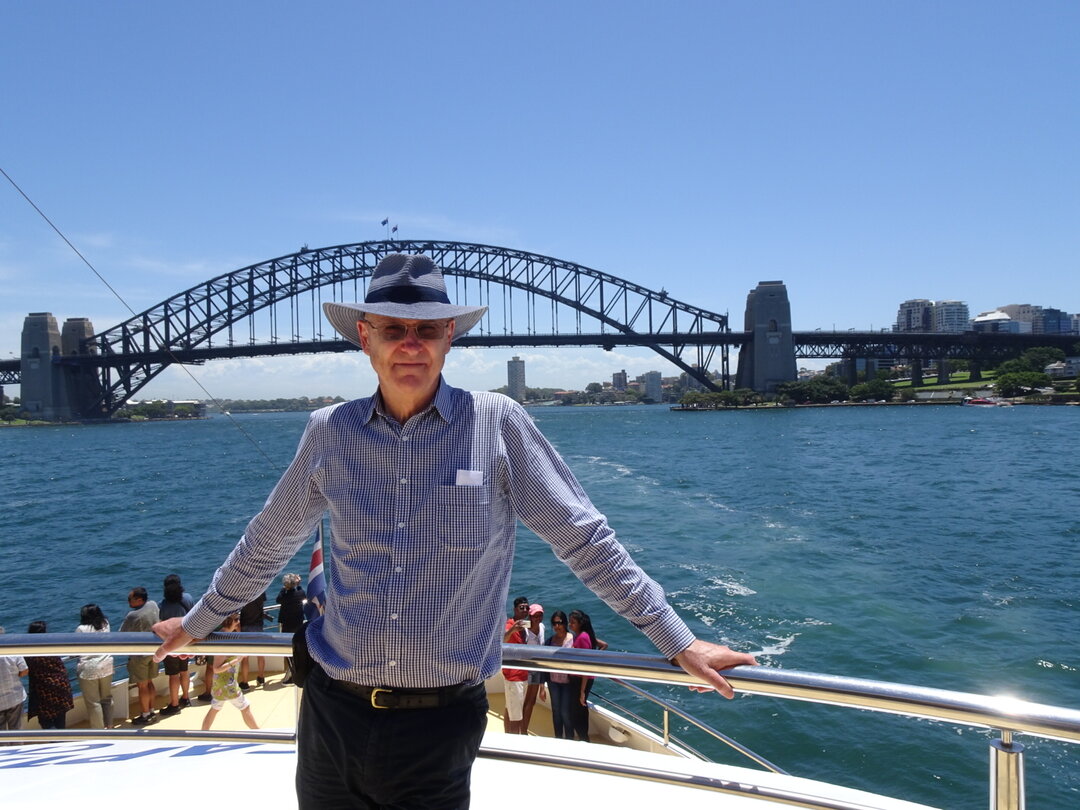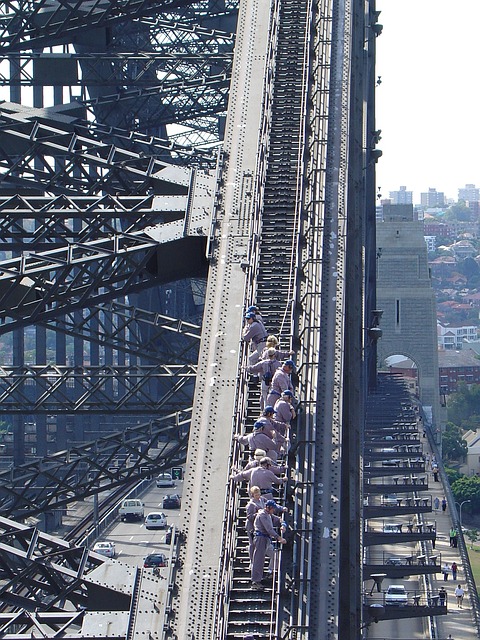Learn English while learning about daily life in Australia, with Rob McCormack
Podcast Number 144 – A Trip to Sydney for the Harbour Bridge Climb
(This podcast is 13 minutes and 51 seconds long.)
Hi,
In podcast 51 (https://slowenglish.info/podcast-51-the-sydney-harbour-bridge/), I talked about Sydney’s famous Sydney Harbour Bridge. When I wrote that podcast, I had not yet completed the bridge climbing tour which allows you to climb it, right to the very top. Since then, my wife Silvia and I have completed that tour and made the climb. It was a wonderful and memorable experience. In this podcast, I would like to talk about the climb.
Sydney is one of my favourite cities in Australia, probably because I and my family lived and worked there from 1989 to 1994. It is a very beautiful city with wonderful sights and attractions including the Sydney Harbour Bridge, the Opera House, the harbour and the coastal beaches, just to name a few. However, in my opinion, the bridge is top of the list, so climbing it is an experience not to be missed. For all the official information about the Bridge Climb tour, you should visit the website at https://www.bridgeclimb.com/.
Silvia and I climbed the bridge in 2018. Since we live in Melbourne, we decided to make a big day of it in Sydney and include other activities as well. Our plan was to fly to Sydney on an early morning flight. Once there, we would have our breakfast at Circular Quay on the harbour, then take a 90-minute Sydney Harbour Luncheon Cruise on a large harbour cruise yacht, starting at 12.00 noon, which included a 3-course restaurant meal onboard while cruising the wonderful Sydney Harbour. There are many companies offering such harbour cruises and I can really recommend them. (See https://www.sydney.com/destinations/sydney/sydney-city/sydney-harbour/cruises).
We planned to do the Bridge Climb tour in the late afternoon, so that we could see Sydney from the top of the bridge in the fading light of the sunset. This would take around 2 and a half hours, after which we would head back to the airport and fly back to Melbourne, arriving back home after 10pm. It was going to be a long and busy day, but hopefully an enjoyable one.
On the day of our trip, we flew to Sydney early, arrived at around 8 am and caught a train to the city. Having breakfast at one of the cafes at Circular Quay is a great way to start your day in Sydney. This is one of my favourite places in Sydney, as harbour ferries are constantly arriving and leaving from the jetty just 10 metres away from our table. The ferry commuters of Sydney and many tourists and sightseers are walking along the walkways next to the harbour, either heading into the city to work or looking for their next ferry departure.
With about 2 hours to spare before our harbour cruise, we next walked to the Welcome Wall at the Australian National Maritime Museum in Darling Harbour, a distance of around 2.4 kilometres. The Welcome Wall displays an engraved listing of the names of around 30,000 migrants to Australia, which is just a very small sample of the millions of migrants who have made their lives in Australia through migration since European settlement. My wife’s family is listed on the Wall, including my wife’s name. She was 9 years old when she arrived in Australia as a migrant from Austria back in 1963. The Wall reminds people of the great contribution made by migrants to our development and our way of life here in Australia. While at the Wall, we talked about the adventurous spirit of Silvia’s mother who made the decision to migrate with her children to Australia. Her bold decision and her determination to get a better life were important in making their new life in Australia a great success. She has passed on now, but Silvia is forever grateful to her mother for that.
We then walked back to catch our luncheon cruise at Circular Quay at midday. When we boarded our harbour yacht, we were pleasantly surprised to find that our table for two was on the top deck, right next to the front facing windows. The view was magnificent over the bow of the boat. We thought, it’s our lucky day. The boat left the Quay and we soon sailed under the bridge and around the harbour. As we enjoyed the views, we were served our 3 courses for lunch. The food was excellent and the service was very friendly.
Sailing under the Harbour Bridge is always a treat. You get a real feel for how high the bridge actually is above the water – it is 134 metres to the top of the arch and 53 metres to the roadway.

Sailing under the Bridge.
Image by pele green from Pixabay
After enjoying our 90-minute cruise and our great lunch, we returned to Circular Quay. We disembarked and went for a walk around Circular Quay and past the Opera House. Finally, it was time to go to the Bridge Climb tour office, which is at the end of the bridge.
Climbing of the bridge only started in October 1998. Prior to then, it was thought by the government to be too dangerous – for those climbing and those below using the bridge, both in cars or as pedestrians on the bridge’s walkways. Obviously, those climbing could fall to their death, and those using the bridge might have things dropped on them from the climbers above, such as cameras or phones. So all these concerns had to be addressed and the climb had to be 100% safe before it was approved. All this means that, to climb the bridge, you must comply with a strict set of rules and conditions. It’s all about keeping everybody safe. The Bridge Climb website has a full and detailed list so you should check it out for all the requirements. https://www.bridgeclimb.com/plan-your-visit/pre-climb-checklist.
Here are just a few examples. You must wear suitable shoes and the climbing suit provided. All your belongings must be left behind, meaning no phones, no cameras, no wrist watches, no hats, no necklaces, nothing at all except glasses, which will be attached to your climb suit. All your belongings are stored in a secure locker at the Bridge Climb office. If you are 75 years or older, or pregnant, or have a medical condition, then you must organize to get a special Certificate of Fitness to Climb completed by your doctor in advance. In addition, every climber must complete and sign a Bridge Climb Health Declaration Form before they can climb. It sounds complicated, but it’s not that difficult. These steps are to ensure safety for all and, at the end of the day, are all worth it in order to experience the climb. When you are climbing, you will wear a safety harness over your climb suit. At all times during the climb, the harness is attached to a safety wire along the route that you take. This ensures that nobody can fall and is the ultimate safety device.
But enough of talking about the safety rules. The climb is amazing. You get to see the bridge close up, how it was constructed and put together. Your group tour guide gives you lots of interesting facts and anecdotes about the bridge as you climb. The views are stunning in all directions. There are 1332 steps to get to the top of the bridge, some on walkways and some up stairs. At all times during the climb, we felt safe and found the information from our tour guide extremely interesting. Here are some facts about the climb. Over 4 million people have climbed the bridge so far. The youngest climber is 8 years old and the oldest 100 years old. Over 5000 couples have become engaged while on the Bridge Climb, and there have been 31 weddings conducted on the Bridge Climb. When at the top, you are 134 metres above the water. There are around 6 million steel rivets in the bridge. Total weight of the steel in the bridge is 52,800 tonnes. (See my Podcast 51 for more information).
The best part of the climb is reaching the top and being amazed at the sights of Sydney in all directions, from the ocean, the suburbs, the harbour and the Blue Mountains in the distance. We had the added pleasure of watching the colours of the sky change as the sun went down.
Finally, we started our way back down. We reached the bottom just in time to retrieve our belongings and head to the airport. What a day it was. If you come to Sydney, I highly recommend that you climb the Sydney Harbour Bridge.
If you have a question or comment to make, please leave it in the comments box at the bottom of this page. Or, you can send me an email at rob@slowenglish.info. I would love to hear from you. Tell me where you live, a little bit about yourself and what you think of my Slow English podcast. I will write back to you, in English of course. If you would like to take a short quiz to see if you have understood this podcast, you will also find it on my website. Goodbye until next time.
Rob
Podcast 144 Quiz - Did you understand the podcast?
You can take the quiz as many times as you like.
Vocabulary
activities = things to do
addressed = solved
adventurous spirit = an attitude where you look for adventure
amazed = when you are surprised by something, usually in a good way
anecdotes = short stories
approved = when someone has agreed with a request you have made
arch = a curve, like part of a circle
attached = connected
attractions = things of interest which you can see
Australian National Maritime Museum = a museum in Sydney with information about sailing and ships
belongings = the things you own, the things that belong to you
bold = brave, prepared to take a risk
bow = the front of a boat or ship
check it out = to look at something
Circular Quay = the place in Sydney where the ferries and ships stop to collect passangers
commuters = people who travel by car, train or ferry to their work place
completed = done, finished
complicated = difficult to do or understand
comply = when you agree to follow the rules
concerns = worries
conditions = (here) the things that you must do as part of an agreement
conducted = carried out, took place, happened
constructed = made, built
contribution = when you do something which is good for others
couples = two people who are together
deck = the floor on a ship or boat
departure = when a ferry, train, bus or plane leaves
determination = when someone wants to reach a goal and works very hard for it
development = the process of growing, getting better, improving
device = a small machine or piece of equipment
disembarked = get off a ship or boat
displays = (here) shows
engaged = when two people agree to be married in the future
engraved = when writing is cut into a hard surface such as metal, concrete or rock
ensures = makes sure that something happens
experience = something you have done before
extremely = very
fading = becoming darker
famous = someone or something which is well known by a lot of people
ferries = small ships which carry passengers across the water for a fee
grateful = thankful
harness = a one-piece strap which goes around your body for safety
in advance = before
include = (here) to add in
luncheon cruise = to have lunch on a boat while it takes you around the harbour
medical condition = something wrong with your health
memorable = easily remembered, stays in your memory
migration = when someone goes to another country to live and does not return.
official = (here) the information which is accurate and up to date.
passed on = a polite way to say someone has died
pedestrians = people who are walking
pregnant = having a baby
prior = before, previously
provided = given to you
requirements = needs, the things which must be done
retrieve = to get back
rivets = pieces of metal used to hold larger pieces together
sample = a part
secure locker = a place where you can put your things, which can be locked
served = when other people have brought things to you
settlement = when people go to live in a new place and stay there
stunning = beautiful, amazing
suburbs = and area of a city where the people live
suit = clothing which goes from neck to ankle
tour = when you visit a place of interest and someone explains what it is all about
tour guide = a person who takes you on a tour and tells you about a place
treat = a happy experience
ultimate =(here) the best
walkways = a wide footpath where people can work
wire = a thin line of metal
yacht = (here) a small ship, usually carrying many passengers in great comfort



April 5, 2023 at 9:25 pm
You are the best
April 5, 2023 at 9:54 pm
Hi Hector,
Many thanks for your comment and your kind words. Much appreciated.
Have a great day.
Rob
January 16, 2023 at 6:17 am
Hi Rob , I am from Brazil . I love your podcast . Thanks a lot . I would like one podcast about the famous Tim Tam . What do you think ? See you Eduardo
January 16, 2023 at 11:32 am
Hi Eduardo. Many thanks for your comment and feedback. Much appreciated. That’s a great idea for a podcast topic. I’ll add it to my list.
Have a great day.
Rob.
December 28, 2022 at 5:42 pm
Hi Rob, how are you?
I am a newbee to Australia, I am suffering some language problem like you said in Introduction. Fortunately, I found your podcast today when I searched on internet trying to find some classes that might help me to change my situation. How amazing that you have been persisting to make this programme full of rich contents. I am gonna learn from your podcast everyday. Thank you and Happy New Year in advance!
Rey
December 28, 2022 at 8:09 pm
Hi Rey,
Many thanks for your comment. I really appreciate your feedback. Welcome to Australia! I hope you are enjoying life here and that 2023 is an exciting and fulfilling year for you.
Best regards,
Rob.
December 24, 2022 at 7:16 pm
Many thanks Rob for all your very interesting podcasts and merry Christmas 2022.
I live in France (SW)…. definitely addicted to your « slow English » ?
Cheers,
Janine
December 24, 2022 at 8:36 pm
Hi Janine. Many thanks for your kind words. Have a merry Christmas and happy new year. Regards, Rob.